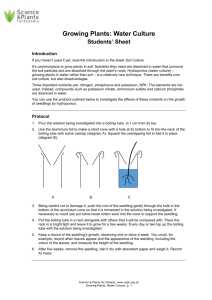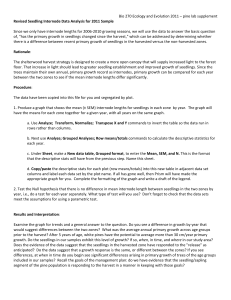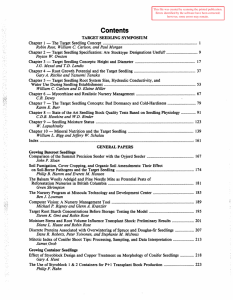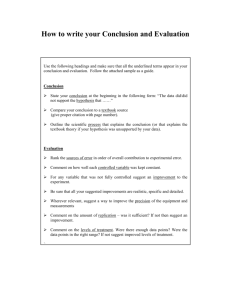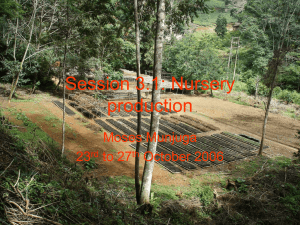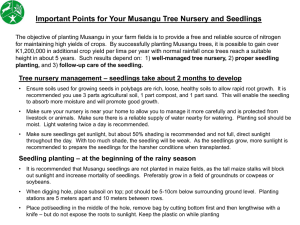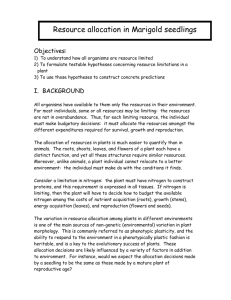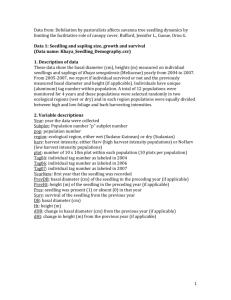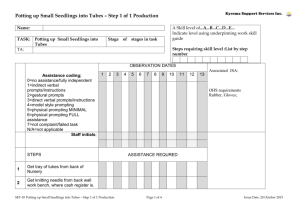Growing Vegetables Seedlings - Training the Next Generation of
advertisement
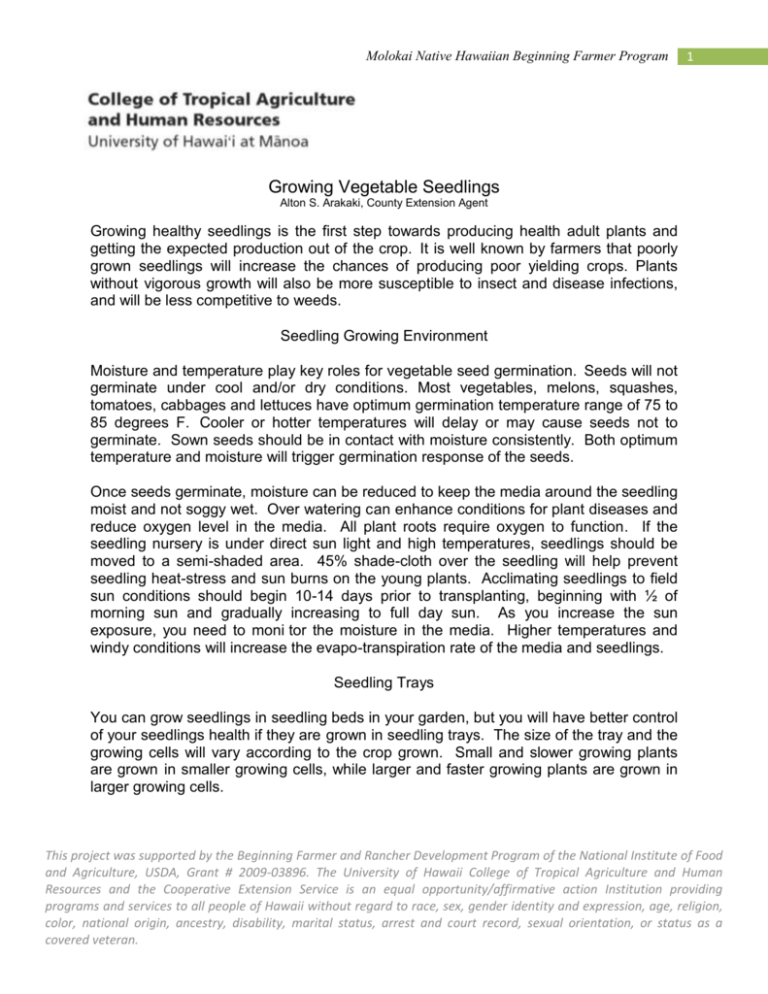
Molokai Native Hawaiian Beginning Farmer Program 1 Growing Vegetable Seedlings Alton S. Arakaki, County Extension Agent Growing healthy seedlings is the first step towards producing health adult plants and getting the expected production out of the crop. It is well known by farmers that poorly grown seedlings will increase the chances of producing poor yielding crops. Plants without vigorous growth will also be more susceptible to insect and disease infections, and will be less competitive to weeds. Seedling Growing Environment Moisture and temperature play key roles for vegetable seed germination. Seeds will not germinate under cool and/or dry conditions. Most vegetables, melons, squashes, tomatoes, cabbages and lettuces have optimum germination temperature range of 75 to 85 degrees F. Cooler or hotter temperatures will delay or may cause seeds not to germinate. Sown seeds should be in contact with moisture consistently. Both optimum temperature and moisture will trigger germination response of the seeds. Once seeds germinate, moisture can be reduced to keep the media around the seedling moist and not soggy wet. Over watering can enhance conditions for plant diseases and reduce oxygen level in the media. All plant roots require oxygen to function. If the seedling nursery is under direct sun light and high temperatures, seedlings should be moved to a semi-shaded area. 45% shade-cloth over the seedling will help prevent seedling heat-stress and sun burns on the young plants. Acclimating seedlings to field sun conditions should begin 10-14 days prior to transplanting, beginning with ½ of morning sun and gradually increasing to full day sun. As you increase the sun exposure, you need to moni tor the moisture in the media. Higher temperatures and windy conditions will increase the evapo-transpiration rate of the media and seedlings. Seedling Trays You can grow seedlings in seedling beds in your garden, but you will have better control of your seedlings health if they are grown in seedling trays. The size of the tray and the growing cells will vary according to the crop grown. Small and slower growing plants are grown in smaller growing cells, while larger and faster growing plants are grown in larger growing cells. This project was supported by the Beginning Farmer and Rancher Development Program of the National Institute of Food and Agriculture, USDA, Grant # 2009-03896. The University of Hawaii College of Tropical Agriculture and Human Resources and the Cooperative Extension Service is an equal opportunity/affirmative action Institution providing programs and services to all people of Hawaii without regard to race, sex, gender identity and expression, age, religion, color, national origin, ancestry, disability, marital status, arrest and court record, sexual orientation, or status as a covered veteran. Molokai Native Hawaiian Beginning Farmer Program Crop Tomato Pepper Eggplant Lettuce Broccoli Cucumber Watermelon Cell Size (inches) ¾ to 1 ¾ to 1 ¾ to 1 ¾ to 1 ¾ to 1 1½ 1½ 2 Transplant (weeks after seeding) 4 to 5 6 6 3 to 4 4 2 2 Media Store bought “ready-to-use” potting media is the simplest to use. Most commercial media mixes are sterile, free of nematodes, diseases, and grass seeds. Some are pH balance and others have fertilizer mixed in them. You can mix your own by purchasing individual additives such as peat moss, perlite or vermiculite. Or you can use media you have around your home, soil, sand, manure, compost or organic mulch. When using home potting medium, you will need to work out your own recipe, because each soil, manure and compost will have different texture and nutritional value that will affect the final media composition. 50 qt. 4 c. 2 c. Mixture #1 Ready to use potting media 14-14-14 slow release fertilizer (osmocote) Lime or calcium carbonate or coral 25 qt. Mixture #2 Peat moss 16 qt. 25 qt. Perlite or vermiculite 16 qt. 5 qt. Sand (coral beach sand) 16 qt. Mixture #3 Soil Humus/organic mulch/ compost/ cured manure Sand 4 c. 14-14-14 slow release 4 c. 14-14-14 slow release fertilizer fertilizer (osmocote) (osmocote) Mixture #1- Table of Equivalence Additives Equivalence Equivalence Equivalence Equivalence Equivalence Ready-to-Use Potting Media 50#1qt. 25#2qt. 12.4 4 qt. #4 (1 gal) 1#5 qt. #3qt. 14-14-14 Slow release fertilizer 4 c. 2 c. 1 c. 2.6 fl. oz .65 fl.oz, or 5 Tbsp 19.22 ml or 4 tsp Lime or calcium carbonate or coral 2 c. 1 c. ½ c. 1.3 fl. oz. .32 fl.oz. or 9.46 ml or 2 tsp This project was supported by the Beginning Farmer and Rancher Development Program of the National Institute of Food and Agriculture, USDA, Grant # 2009-03896. The University of Hawaii College of Tropical Agriculture and Human Resources and the Cooperative Extension Service is an equal opportunity/affirmative action Institution providing programs and services to all people of Hawaii without regard to race, sex, gender identity and expression, age, religion, color, national origin, ancestry, disability, marital status, arrest and court record, sexual orientation, or status as a covered veteran. Molokai Native Hawaiian Beginning Farmer Program 3 Measurement Key 1 pt.=473 ml 1 pt=2c. 1 c=8 fl. oz 1 fl. oz.=2 Tbsp 1 Tbsp=3 tsp 1 tsp=.333 Tbsp 1 c.=236 ml 1 fl. oz.=29.5 ml This project was supported by the Beginning Farmer and Rancher Development Program of the National Institute of Food and Agriculture, USDA, Grant # 2009-03896. The University of Hawaii College of Tropical Agriculture and Human Resources and the Cooperative Extension Service is an equal opportunity/affirmative action Institution providing programs and services to all people of Hawaii without regard to race, sex, gender identity and expression, age, religion, color, national origin, ancestry, disability, marital status, arrest and court record, sexual orientation, or status as a covered veteran.



